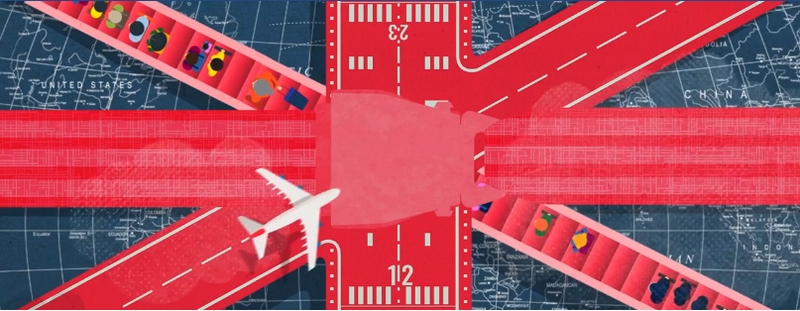
@british airways; @facebook/britishairways
This year, the 16-year-old Swedish climate activist Greta Thunberg travelled across Europe by train before setting sail in a yacht from Plymouth to the US. Thunberg hasn’t flown since 2015 and her journeys have added momentum to the growing #flygskam (a Swedish word meaning flying shame) campaign and triggered a new hashtag #tagskryt (which translates as train brag) with more people following her lead to stay grounded and choose more carbon-conscious modes of transport. The number of Interrail tickets sold in Sweden surged by 45% in 2018 and the Dutch airline KLM has even called for its customers to fly responsibly and consider alternatives where possible.
Scheduled flights emitted more than 900m tonnes of carbon dioxide in 2018 (pdf) and the aviation sector currently accounts for more than 2% of global emissions – if it were a country, aviation would have been the sixth-largest emitter of CO2 last year, emitting more than Germany. Globally, aviation is the fastest-growing source of greenhouse gases, with soaring emissions increasing by about 5% more each year according to the World Health Organization. The International Council on Clean Transportation (ICCT) estimates aviation CO2 emissions are on track to triple by 2050. Generally, ICCT finds that flying short distances is much more fuel-intensive than flying longer distances, so reducing the number of flights (rather than cutting out just long-haul flights) is one of the best things anyone can do to cut carbon. Shorter flights are less efficient – with up to 25% of jet fuel consumed during takeoff – but longer flights have a larger carbon footprint.
In 2019, almost 40m flights are expected to depart from airports worldwide, yet flying is a luxury that relatively few of us can afford to enjoy. In fact, WWF estimates that 95% of the world’s population has never set foot on a plane – and yet climate change affects everyone, particularly poorer communities from the global south, while frequent flyers in the global north are creating the biggest carbon footprints.
A paper published by Seth Wynes and Kimberley Nicholas in 2017 found that the most effective high-impact individual actions that significantly reduce greenhouse gas emissions are: becoming car-free; eating a plant-based diet; avoiding flying; and having one fewer child. The authors conclude that these all have the potential to contribute to systemic change.
The Flight Free UK campaign group encouraged 100,000 people to take a no-fly year in 2020 – and more than 3,000 people have signed up. Anna Hughes, its director, last flew a decade ago and holidayed in the Lake District this summer. “Train journeys are part of the holiday, rather than just a means of getting there. You can relax more, there’s space to move around and more of your travel time is productive, without the need to queue for hours or wait at airports for lengthy transfers. Seeing the landscape change is much more enjoyable than zipping over it in a plane. In our must-have-everything-now society, such experiences are a rarity.”
Aviation is one the most carbon-intensive forms of transport, whether measured per passenger km or per hour travelling, according to the Aviation Environment Federation. Another often-overlooked characteristic of air travel is the range of non-CO2 impacts that occur at altitude. In addition to carbon, planes emit other kinds of exhaust fumes and soot particles in their contrails that trigger a series of chemical reactions and atmospheric effects that have a net warming effect. Night flights have the strongest warming impact because contrails actually reflect sunlight away from the earth during the day.
Habits are changing. Sixty-five percent of Brits want to adapt their journeys and choose more sustainable options, according to recent research by Trainline, but a common concern is journey time. A new initiative aims to tackle this by encouraging employers to give staff paid journey days to travel if they choose not to fly. Climate Perks, a two-year pilot being launched this November by climate action charity 10:10, aims to get staff excited about taking alternative modes of transport, as campaign manager Emma Kemp explains: “Flying has become the default travel choice for those holidaying abroad, so this project empowers people to choose more planet-friendly options, such as coaches, ferries and trains. Trains are a really strong option; they have a much lower carbon impact than flying, they offer beautiful views and they can be cheaper, especially if you book a couple of months in advance.”
To date, 10:10 and a handful of early adopters, including Wholegrain Digital and Glimpse, have implemented Climate Perks into their HR policies, and polling by 10:10 shows there’s a genuine appetite for this. “We found that 50% of people are willing to reduce the amount they fly but only 3% currently do. The main barrier cited was time, so Climate Perks offers a real solution,” says Kemp, who hopes this will be rolled out nationally. “While businesses are declaring climate emergencies, this gives staff an opportunity to do something really practical, and our ultimate goal is for this to become a standard part of any HR policy.”
With the new Caledonian Sleeper trains from London to Scotland and the Eurostar from London to Amsterdam, it’s becoming easier than ever to stay grounded and still seek adventure.
Book travel in and across 45 countries today with Trainline, Europe’s leading train and coach app
guardian.co.uk © Guardian News & Media Limited 2010
Published via the Guardian News Feed plugin for WordPress.

